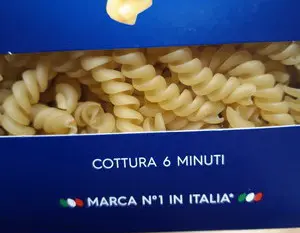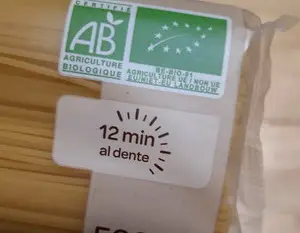Cooking time for pasta

What is as good and simple as pasta? Not much, I think, and it's so easy to prepare: boiling water, salted (or not, depending on your taste), a few minutes of boiling and it's ready.
The only "difficulty", so to speak, is the respect of the cooking time and the risk of, unfortunately, overcooking your pasta.
The only "difficulty", so to speak, is the respect of the cooking time and the risk of, unfortunately, overcooking your pasta.
22 K 4.6/5 (19 reviews)
Keywords for this post:PastaTimeCookingAl denteItalyLast modified on: July 18th 2019
Cooking time for pasta
As always with pasta, we must take inspiration from the masters that are the Italians, they are very attached, and rightly so, to a rigorous and fair cooking, the famous "al dente".
Cooking is very precise: the pasta is plunged into boiling salted water and left for the precise number of minutes indicated on the packet, a number which depends on the nature of the pasta: 5, 6, 7 minutes or more, then drained and eaten or served.
Impossible to miss? In principle not, but there is a very easy mistake to make, it is to overcook, and thus to have overcooked pasta which becomes sticky, and much less good.
An Italian friend of mine pointed out to me that "At home" (in France) pasta is always overcooked, no matter where you go to eat it. It's not that it's inedible, just that it's a little overcooked, usually by a minute or so.
It's not always the cook's fault, the mistake is often already on the package, so she pointed me to this great tip.
Respect the time indicated precisely (here 6 minutes)
Subtract 1 minute from the indicated cooking time, so here 12 - 1 = 11 minutes.
With this simple rule, you should have pasta that is always al dente.
To sum up: The cooking time is indicated not in Italian on the package => subtract one minute from the indicated time, the cooking time is indicated in Italian, do not change anything.
Cooking is very precise: the pasta is plunged into boiling salted water and left for the precise number of minutes indicated on the packet, a number which depends on the nature of the pasta: 5, 6, 7 minutes or more, then drained and eaten or served.
Impossible to miss? In principle not, but there is a very easy mistake to make, it is to overcook, and thus to have overcooked pasta which becomes sticky, and much less good.
An Italian friend of mine pointed out to me that "At home" (in France) pasta is always overcooked, no matter where you go to eat it. It's not that it's inedible, just that it's a little overcooked, usually by a minute or so.
It's not always the cook's fault, the mistake is often already on the package, so she pointed me to this great tip.
If you have a package of pasta where it is written in Italian

Respect the time indicated precisely (here 6 minutes)
If you have a packet of pasta where it is written in a language other than Italian

Subtract 1 minute from the indicated cooking time, so here 12 - 1 = 11 minutes.
With this simple rule, you should have pasta that is always al dente.
To sum up: The cooking time is indicated not in Italian on the package => subtract one minute from the indicated time, the cooking time is indicated in Italian, do not change anything.
Lasts posts
The importance of sieving
In recipes that use a fine powder (flour, powdered sugar, etc.), you'll often see the advice to sift before using it. To sift is to pass the powder in question through a sieve (a very fine strainer) before incorporating it into your recipe. It's often advice, but is it really useful?September 3rd 20251,161
The grease spray
As soon as you have something in a recipe that sticks to the mold, the question always arises as to how difficult it is to remove from the mold. There's nothing more frustrating than breaking your cake when unmolding it, because part of it has stuck in the mold. The classic way to avoid this is...August 26th 20254,4175
Cake moulds
When we make a cake, or a cake of the same rectangular shape, we usually take out our usual mould and tell ourselves that the recipe is anyway "for a cake", but is it really that simple?August 25th 20254,7335
Thinning out herbs
If you need to add a long-stemmed herb (tarragon, mint, verbena, thyme, etc.) to a recipe, you'll probably only need the leaves and not the stem, so you'll need to remove the leaves. Leaf removal means keeping only the beautiful leaves, and eliminating the ugly stems and leaves, but how do you do...August 8th 20252,9435
Add a bay leaf
Bay leaf: small in size, but big in flavor. You'll find it in hundreds of recipes, and it's often added to cooking meat, in a sauce or broth, usually accompanied by other herbs or products. It's a staple of Provençal, Mediterranean and Oriental cuisine, but not the only one. Usually, in a...July 31th 20253,0475
Other pages you may also like
The importance of sieving
In recipes that use a fine powder (flour, powdered sugar, etc.), you'll often see the advice to sift before using it. To sift is to pass the powder in question through a sieve (a very fine strainer) before incorporating it into your recipe. It's often advice, but is it really useful?September 3rd 20251,161
The window-pane test in bread-making
The home bread-makers often ask themselves “Have I kneaded my dough long enough?” . A good question, as dough that is insufficiently kneaded will not rise properly or will fall flat when the top is slashed, which is very frustrating. To know when the dough is ready, one can rely on the length...June 16th 202194 K 23.9
The return of the "Norman hole"
You maybe know the "trou normand", this old gastronomic custom typically French which consists in taking a (small) glass of calvados, generally between the last course and the dessert? It's something that seems a bit anachronistic nowadays, having a glass of an alcohol of more than 60° in the...December 18th 202113 K4.8
A drizzle of olive oil
Often in a recipe, you have to "baste" vegetables, for example, before sending them to the oven. What the author means by this is that you need to put oil on top of the vegetables to cook them in the oven. Typically, we just quickly drizzle oil over the vegetables, hoping not to miss any, but...July 13th 20253,2164
85 grams of eggs?
Some time ago, I already spoke to you about the difference between baking and pastry-making, I emphasized, among other things, the precision of pastry-making which requires grams, cm, degrees and minutes. That's why, on the one hand, you have baking and cooking, where a certain tolerance is...November 26th 201854 K4.6
Post a comment or question
Follow this page
If you are interested in this page, you can "follow" it, by entering your email address here. You will then receive a notification immediately each time the page is modified or a new comment is added. Please note that you will need to confirm this following.
Note: We'll never share your e-mail address with anyone else.
Alternatively: you can subscribe to the mailing list of cooling-ez.com , you will receive a e-mail for each new recipe published on the site.








